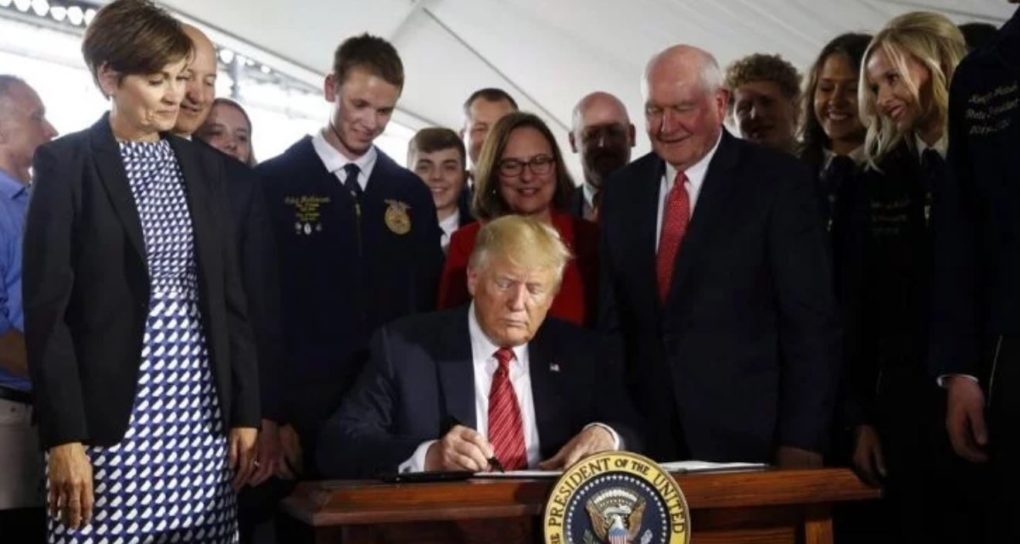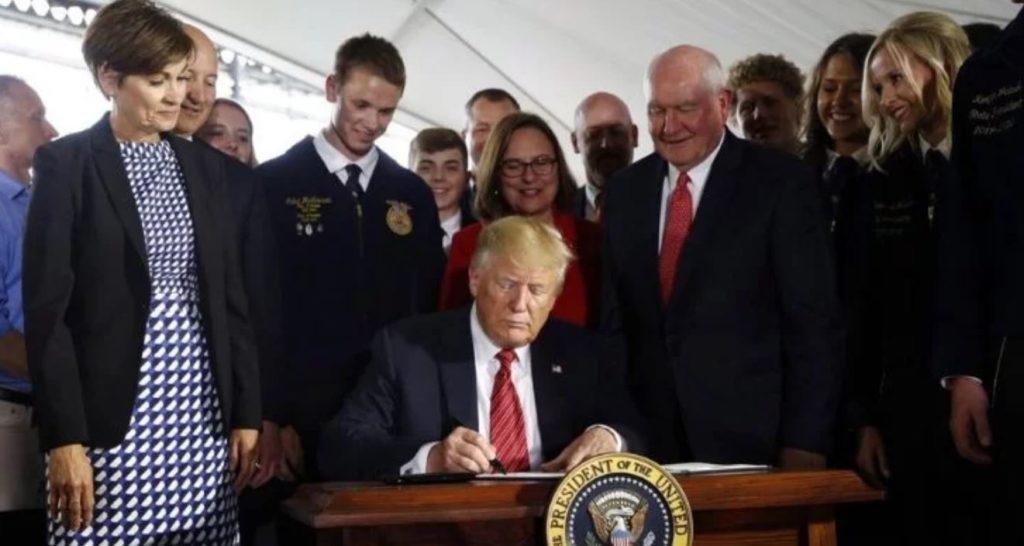Trump Just Made It a Lot Easier for GMOs to Enter the Food Supply
On June 11, President Donald Trump quietly issued an executive order to “streamline” GMO regulations in the United States. The order, titled Modernizing the Regulatory Framework for Agricultural Biotechnology Products, is the latest move by the Trump administration aimed at promoting the use of genetically engineered or modified crops.
In his executive order, Trump called on federal agencies to fix what he called a “regulatory maze” related to the farming and selling of GMO products.
The executive order states:
Biotechnology can help the Nation meet its food production needs, raise the productivity of the American farmer, improve crop and animal characteristics, increase the nutritional value of crop and animal products, and enhance food safety. In order to realize these potential benefits, however, the United States must employ a science-based regulatory system that evaluates products based on human health and safety and potential benefits and risks to the environment. Such a system must both foster public confidence in biotechnology and avoid undue regulatory burdens.
Widget not in any sidebars
The order goes on to instruct the Secretary of Agriculture and other officials to “develop an action plan to facilitate engagement with consumers in order to build public confidence in, and acceptance of, the use of safe biotechnology in agriculture and the food system” [emphasis added].
The executive order also lays out plans for the Trump administration to work with other nations in developing GMO policies. Section 8 of the order gives the Ag Secretary and Secretary of State 180 days to develop an international communications and outreach strategy to facilitate engagement abroad with policymakers, consumers, industry, and other stakeholders.
Additionally, the order calls on the Department of Agriculture, the Environmental Protection Agency, and the Food and Drug Administration to design a website that contains and provides links to relevant United States Government regulatory information.
Greg Jaffe, biotechnology director at the Center for Science in the Public Interest, told the Associated Press that the impact of the order depends on how the federal government responds. “There needs to be an assurance of safety for those products,” Jaffe said.
The topic of genetically engineered food has been controversial for years. Scientists, health advocates, and concerned citizens have been raising questions about the technology over the last decade, including activists forming global marches against biotechnology giant Monsanto between 2013 and 2016.
More recently, criticism of GMOs has centered around labeling laws. To understand the current battle for labeling genetically engineered foods, one must look back to 2015. At that time, the controversial Safe and Accurate Food Labeling Act passed the House in June before ultimately failing amid heavy opposition.
To critics, the bill was known as the “DARK” (Deny Americans the Right to Know) Act because the law was also aimed at nullifying GMO labeling measures, such as a state labeling bill passed in Vermont. Mike Pompeo, author of the bill, criticized mandatory labeling laws as unnecessarily costly and insisted a federal standard was the answer.
In late February 2016, U.S. Senate Agriculture Committee Chairman Pat Roberts introduced another bill which attempted to create a federal voluntary standard for labeling GE food. Roberts’ Senate Bill 2609, or the Biotech Labeling Solutions Act, would have blocked mandatory labeling efforts by states.
In March 2016, the bill failed to reach the 60 votes needed during a procedural vote, with 49 votes in favor and 48 votes against. However, by July 2016 the labeling measure was added to the National Sea Grant College Program Act as the National Bioengineered Food Disclosure Standard. It was that measure which was ultimately signed into law by Obama, placing the U.S. Department of Agriculture in charge of labeling America’s genetically engineered food supply.
Under the Trump administration, the battle for labeling has died down largely due to a lack of reporting in the mainstream press and misinformation which falsely tells Americans that labeling rights have been won.
However, in July 2018, an analysis of proposed rule changes revealed that thousands of genetically engineered foods may be exempt from upcoming labeling requirements. In early May 2018, the Department of Agriculture released a draft rule describing how the labeling law is supposed to be implemented.
Between May and July 3, the USDA received 14,008 public comments. The comments indicate that some of the public is concerned about the language used in the rule. “The term bioengineered should not be used. It is both misleading and confusing to consumers. GMO, GE or Genetic Engineering should be used instead,” one commenter writes. “Please make all food items labeled correctly as GMO so consumers know exactly what they are purchasing,” another said.
The Environmental Working Group reports that if companies want to label foods which are made with genetically engineered ingredients, they must use the terms “bioengineered” or “bioengineered food ingredient,” instead of the widely known phrases “genetically modified” or “genetically engineered.”
Interestingly, the International Food Information Council (IFIC) recently conducted a survey to see how people respond to these different labels, including new symbols being tested by the USDA. The IFIC found that in every combination of label, the level of concern among consumers increased. In the survey consumers were shown bottles of canola oil without any label, with one of three symbols (plant, sun, or smile), with a symbol plus “bioengineered” on the label, and a symbol with “may be bioengineered” on the label.
As the USDA works to establish a uniform national standard for labeling foods that may be genetically engineered, critics continue to call out the dangers of putting the federal government in charge of the situation. Donald Trump’s recent executive order will only exacerbate the already confusing situation.
Americans who have concerns about the safety of GMOs will have to wrestle with the fact that these products may not be labeled and—with the latest executive order from Trump—will enter the food supply at an increasing pace in the coming years.
By Derrick Broze | Creative Commons | TheMindUnleashed.com
Subscribe to Natural Blaze for health freedom and natural living headlines to your inbox. Follow Natural Blaze on Twitter and Facebook.




